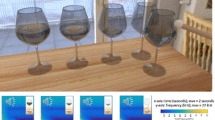Abstract
Both visual information and sound are required in immersive virtual reality. This paper proposes a computational method for fast synthesis of plausible fire sound that is synchronized with physically based fire animations. We divide fire sound into two parts: low frequency and mid- to high frequency, and use two processes to separately synthesize these two parts. By simplifying calculations using a novel combustion sound model as well as leveraging GPU parallel computing in a marching-cube-like manner, our method speeds up the computation of low-frequency part by an order of magnitude. To run the time-stepping fire simulation at a relative low frequency rather than the audio rate, we add synchronized mid- and high-frequency wavelet details to low-frequency simulation contents with a post-process to generate complete fire sound. We validated our method with various experiments to build a solid physically based basis for real-time acoustic rendering that can be used for immersive virtual reality scenarios.










Similar content being viewed by others
References
Abugov DI, Obrezkov OI (1978) Acoustic noise in turbulent flames. Combust Explos Shock Waves 14(5):606–612
Chadwick JN, James DL (2011) Animating fire with sound. ACM Trans Graph 30(4):1–8
Coenen A, De Vos A (1992) FFT-based interpolation for multipath detection in GPS/GLONASS receivers. Electron Lett 28(19):1787–1788
Cook RL, DeRose T (2005) Wavelet noise. ACM Trans Graph 24(3):803–811
Crighton DG, Dowling AP, Ffwocs Williams JE, Heckl MA, Leppington FA (1992) Modern methods in analytical acoustics. Springer, Berlin
Dobashi Y, Yamamoto T, Nishita T (2003) Real-time rendering of aerodynamic sound using sound textures based on computational fluid dynamics. ACM Trans Graph 22(3):539–545
Dobashi Y, Yamamoto T, Nishita T (2004) Synthesizing sound from turbulent fields using sound textures for interactive fluid simulation. Comput Graph Forum 23(3):736–744
Freeman WT, Jones TR, Pasztor EC (2002) Example-based super-resolution. IEEE Comput Graph 22(2):56–65
Hertzmann A, Jacobs CE, Oliver N, Curless B, Salesin D (2001) Image analogies. ACM Trans Graph 20(3):327–340
Ihme M, Pitsch H, Bodony D (2009) Radiation of noise in turbulent non-premixed flames. Proc Combust Instit 32(1):1545–1553
Imura M, Nakano Y, Yasumuro Y, Manabe Y, Chihara K (2007), Real-time generation of CG and sound of liquid with bubble. In Proceedings of SIGGRAPH posters
Keys RG (1981) Cubic convolution interpolation for digital image processing. IEEE Trans Audio Speech Lang Process 29(6):1153–1160
Kim T, Thurey N, James D, Gross M (2008) Wavelet turbulence for fluid simulation. ACM Trans Graph 27(3):50
Liu S, An T, Gong Z, Hagiwara I (2012) Physically based simulation of solid objects’ burning. Trans Edutain 7:110–120
Mallat SG (1989) A theory for multiresolution signal decomposition: the wavelet representation. IEEE Trans Pattern Anal Mach Intell 11(7):674–693
Marelli D, Aramaki M, Kronland-Martinet R, Verron C (2010) Time-frequency synthesis of noisy sounds with narrow spectral components. IEEE Trans Audio Speech Lang Process 18(8):399–414
Mitchell DP, Netravali AN (1988) Reconstruction filters in computer graphics. Comput Graph 22(4):221–228
Nguyen DQ, Fedkiw R, Jensen HW (2002) Physically based modeling and animation of fire. ACM Trans Graph 21(3):721–728
O’Brien JF, Cook PR, Essl G (2001) Synthesizing sounds from physically based motion. ACM Trans Graph 20(3):529–536
Perlin K (1985) An image synthesizer. Comput Graph 19(3):287–296
Ren Z, Yeh H, Lin M (2010) Synthesizing contact sounds between textured models. In: Proceedings of virtual reality (VR), pp 139–146
Roads C (2004) Microsound. The MIT Press, Cambridge
Serra X, Smith J III (1990) Spectral modeling synthesis: a sound analysis/synthesis system based on a deterministic plus stochastic decomposition. Comput Music J 14(4):12–24
Smith S, Ericson E (2009) Using immersive game-based virtual reality to teach fire-safety skills to children. Virtual Real 13(2):87–99
Stone RJ, Caird-Daley A, Bessell K (2009) SubSafe: a games-based training system for submarine safety and spatial awareness (Part 1). Virtual Real 13(1):3–12
Van Den Doel K, Kry P, Pai D (2001) Foley automatic: physically-based sound effects for interactive simulation and animation. ACM Trans Graph 20(3):537–544
Wang J, Yang X, Lu W (2011) FFT-upsampling for smoke animation. In Proceedings of ACM/eurographics symposium on computer animation poster
Watt A, Maddock SC (2000) Computer games technology and higher education. Virtual Real 5(4):185–194
Zheng C, James DL (2009) Harmonic fluids. ACM Trans Graph 28(3):37
Acknowledgments
The authors would like to thank the anonymous reviewers for their insightful comments. This work was supported by the Natural Science Foundation of China under grant nos. 61170118 and 60803047, and the Application Foundation Research Plan Project of Tianjin under grant no. 14JCQNJC00100.
Author information
Authors and Affiliations
Corresponding author
Rights and permissions
About this article
Cite this article
Liu, S., Yu, Z. Sounding fire for immersive virtual reality. Virtual Reality 19, 291–302 (2015). https://doi.org/10.1007/s10055-015-0271-7
Received:
Accepted:
Published:
Issue Date:
DOI: https://doi.org/10.1007/s10055-015-0271-7




